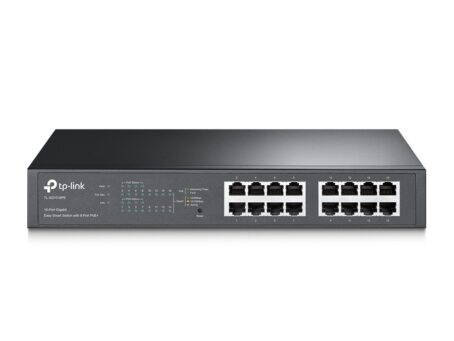TP-Link Switch TL-SG2210P
The TP-Link Switch TL-SG2210P features a comprehensive set of functions, such as Link Aggregation Group, 802.1Q VLAN, Access Control Lists (ACL), Quality of Service (QoS L2 to L4), Storm Control and IGMP Snooping. This allows SMBs to have a network that is ready for growth, while ensuring performance and reliability. In addition, the easy-to-use web management interface means that setup and configuration can be done more quickly.
PoE+ Gigabit Switch
The TL-SG2210P supports 8 ports with IEEE 802.3af-compliant PoE and provides a total power supply of 58 watts for 802.3af-compliant devices. Using wireless access points, surveillance cameras, IP phones, and other PoE-enabled devices is an efficient and economical choice. This eliminates the need for power cables or additional conduits. The TL-SG2210P is flexible and ideal for deploying PoE for wireless access points or IP-based network surveillance cameras for projects or smaller business networks.
Quality of Services
This switch supports Quality of Services (QoS) which allows prioritization within the network. It can be set to prioritize certain data, such as data for video applications, over standard Internet traffic. This ensures that a stable internet connection for the most important data is always guaranteed.
Layer 2 functions for the TL-SG2210P
For more extensive application of layer 2 switches, the TL-SG2210P supports 802.1Q tag VLAN, Port Isolation, Port Mirroring, STP/RSTP/MSTP, Link Aggregation Control Protocol and 802.3x Flow Control function. In addition, the switch offers advanced network maintenance features. For example, Loop Back Detection, Cable Diagnostics and IGMP Snooping. IGMP snooping ensures that the switch intelligently forwards the multicast stream only to the correct devices, while IGMP throttling and filtering restrict each device at the port level, preventing unauthorized multicast access.
Comprehensive management features
It is possible to manage the TP-Link TL-SG2210P through the Omada SDN cloud environment. If this is not used, the switch is managed via intuitive web-based Graphical User Interface (GUI), the Command Line Interface (CLI), SNMP (v1/2/3) or RMON. Conveniently, valuable switch status information can also be queried, as well as error reports for abnormal events. Any problems can thus be detected and resolved more quickly.











